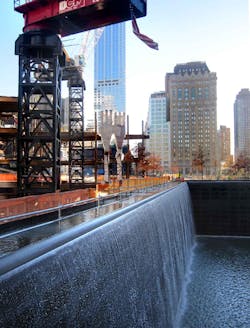Powering the World Trade Center Site
The new World Trade Center site is one of the most complex projects ever undertaken and involves the resurrection of America’s tallest building, the creation of a Memorial Museum featuring the two largest reflecting pools in the world, and a new transportation hub designed to accommodate projected ridership for 2025. Overall, Siemens Industry Inc., the Alpharetta, Ga. supplier of production, transportation and building technology products and services, is providing more than $12 million in building technology, power distribution and automation solutions to the site.
Siemens is supplying more that $5.5 million of low and medium voltage switchgear, as well as energy management and control systems, to provide initial site power and ultimately permanent power for the entire World Trade Center site.
According to the World Trade Center website, 1 World Trade Center (formerly called the Freedom Tower) is being built according to a revised design released in June 2005. The new design retains essential elements of the original plan—an illuminated mast evoking the Statue of Liberty's torch soars 1,776 feet into the sky–but features a smaller base set back further from West Street to protect the building against the possibility of future attacks. Rising from its square base, the skyscraper will taper into eight tall isosceles triangles, forming a perfect octagon at its center. An observation deck will be located 1,362 feet above ground and there will be a square glass parapet at 1,368 feet, the heights of the original Twin Towers. From these, an illuminated spire containing a television antenna will rise to a final height of 1,776 feet.Towers and train stations
Upon completion in 2013, 1 World Trade Center comprises office space, an observation deck, restaurants, and broadcast and antennae facilities. It will also include Siemens electrical power distribution products in 42 separate runs totaling 4,735 feet of power distribution busway and circuit protection (breakers and switches) used in the service and distribution switchboards.
In the separate World Trade Center Port Authority Trans-Hudson (PATH) transportation hub, Siemens low voltage switchgear and automation products will power and control the emergency ventilation system. Part of Siemens Totally Integrated Power (TIP) and Totally Integrated Automation (TIA) architectures, these products can be integrated and adapted to meet the facility’s changing needs over the years.
Located close to the northeast corner of the World Trade Center site between Towers 2 and 3 and connecting the rail and subway lines, the transportation hub is designed to accommodate an estimated 250,000 commuters each day. Retractable, 150-foot-high glass-and-steel "wings" will allow natural light to pass through to the rail platforms 60 feet below street level.
The 9/11 Memorial Museum also will depend on a Siemens power distribution busway and circuit protection. Visitors to the museum will be presented with a sequence of experiences that allow for individual and personal encounters within an overall context of a historical narrative. The nature of the museum is such that the shell of the space, comprising existing foundations, the slurry wall and other in-situ elements of the site, is as much an artifact of 9/11 as the contents of the exhibitions. The museum area also includes two massive reflecting pools with waterfalls. With Delta Fountains of Jacksonville, Fla., Siemens is providing engineering, automation and pump flow control for these water features.
Siemens also is providing $1.7 million in building management controls for the World Trade Center site’s central chiller plant. Fueled by a unique river water condenser system connected to the Hudson River, the chiller plant will cool the transportation hub, 9/11 Memorial Museum and retail space in 1 World Trade Center.Renee Robbins Bassett, [email protected], is managing editor of Automation World. Reporting for this article was provided by Siemens and Sandra Tigert, Robert Jensen, Chris Lesnik, and Natalie ScannellFor More Information“Engineering Ground Zero” is a Nova special report that aired on PBS stations. It covers the designing and building of One World Trade Center and the National 9/11 Memorial and Museum.

